Dynamics of Mulatto Grass Regrowth Depending on Rotational Cattle Grazing Management
Abstract
1. Introduction
2. Materials and Methods
2.1. Location of the Experiment and Climatic Conditions
2.2. Plant Material and Implementation of the Experiment
2.3. Treatments, Experimental Design
2.4. Data Collection and Sampling
2.5. Statistical Analysis
3. Results
4. Discussion
5. Conclusions
Author Contributions
Funding
Institutional Review Board Statement
Informed Consent Statement
Data Availability Statement
Acknowledgments
Conflicts of Interest
References
- Saugier, B.; Roy, J.; Mooney, H.A. Estimations of global terrestrial productivity: Converging towards a single number? In Terrestrial Global Productivity; Roy, J., Saugier, B., Mooney, H.A., Eds.; Academic Press: San Diego, CA, USA, 2001; pp. 543–557. [Google Scholar]
- Still, C.J.; Berry, J.A.; Collatz, G.J.; DeFries, R.S. Global distribution of C 3 and C 4 vegetation: Carbon cycle implications. Glob. Biogeochem. Cycles 2003, 17, 6-1–6-14. [Google Scholar] [CrossRef]
- Edwards, E.J.; Smith, S.A. Phylogenetic analyses reveal the shady history of C4 grasses. Proc. Natl. Acad. Sci. USA 2010, 107, 2532–2537. [Google Scholar] [CrossRef]
- Lambers, H.; Chapin, F.S., III; Pons, T.L. Plant Physiological Ecology; Springers: New York, NY, USA, 2008. [Google Scholar]
- Christin, P.A.; Osborne, C.P. The evolutionary ecology of C 4 plants. New Phytol. 2014, 204, 765–781. [Google Scholar] [CrossRef] [PubMed]
- Jank, L.; Braz TG, S.; Martuscello, J.A. Tropical climate grasses. In Forage Farming: Science, Technology and Management of Forage Resources, 1st ed.; Reis, R.A., Bernardes, T.F., Siqueira, G.R., Eds.; Print shop Multipress: Jaboticabal, Brazil, 2014; pp. 109–124. [Google Scholar]
- Valle, C.B.; Simeão, R.M.; Barrios, S.C.L. Selection and improvement of forage plants. In Forage Farming: Science, Technology and Management of Forage Resources, 1st ed.; Reis, R.A., Bernardes, T.F., Siqueira, G.R., Eds.; Print shop Multipress: Jaboticabal, Brazil, 2014; pp. 109–124. [Google Scholar]
- Argel, M.; Pedro, J.; Miles John, W.; Guiot, G.; Jorge, D.; Lascano, C.E. Cultivar Mulato (Brachiaria Híbrido CIAT 36061): Gramínea de Alta Producción y Calidad Forrajera para los Trópicos. Centro Internacional de Agricultura Tropical (CIAT), Cali, CO. 24p. (Boletim). 2006. Available online: http://ciat-library.ciat.cgiar.org/Articulos_Ciat/CV%20Mulato.pdf (accessed on 13 September 2018).
- Nanamori, M.; Shinano, T.; Wasaki, J.; Yamamura, T.; Rao, I.M.; Osaki, M. Low Phosphorus Tolerance Mechanisms:Phosphorus Recycling and Photosynthate Partitioning in the Tropical Forage Grass, Brachiaria Hybrid Cultivar Mulato Compared with Rice. Plant Cell Physiol. 2004, 45, 460–469. [Google Scholar] [CrossRef]
- Mesquita, E.E.; Neres, M.A.; Oliveira, P.S.R.; Mesquita, L.P.; Schneider, F.; Teodoro Júnior, J.R. Forage yield and growth of “Panicum maximum” cvs. Mombaça and Tanzania-1 and Mulato hybrid Brachiaria under phosphorus application. Rev. Bras. De Saúde E Produção Anim. 2010, 11, 292–302. [Google Scholar]
- Bauer, M.D.O.; Pacheco, L.P.A.; Chichorro, J.F.; Vasconcelos, L.V.; Pereira, D.F.C. Herbage yield and structural characteristics of five Brachiaria genus forages under intermittently defoliation sward. Ciência Anim. Bras. 2011, 12, 17–25. [Google Scholar] [CrossRef]
- Silveira, M.C.T.; Da Silva, S.C.; Souza Júnior, S.J.; Barbero, L.M.; Rodrigues, C.S.; Limão, V.A.; Pena, K.S.; Nascimento Júnior, D. Herbage accumulation and grazing losses on Mulato grass subjected to strategies of rotational stocking management. Sci. Agric. 2013, 70, 242–249. [Google Scholar] [CrossRef]
- Portugal, T.B.; Szymczak, L.S.; de Moraes, A.; Fonseca, L.; Mezzalira, J.C.; Savian, J.V.; Zubieta, A.S.; Bremm, C.; de Faccio Carvalho, P.C.; Monteiro, A.L.G. Low-Intensity, High-Frequency Grazing Strategy Increases Herbage Production and Beef Cattle Performance on Sorghum Pastures. Animals 2022, 12, 13. [Google Scholar] [CrossRef]
- Lemaire, G.; Chapman, D. Tissue flows in grazed plant communities. In The Ecology and Management of Grazing Systems; Hodgson, J., Illius, A.W., Eds.; CAB International, cap.1: Guildford, UK, 1996; pp. 3–36. [Google Scholar]
- Brougham, R.W. A study in rate of pasture growth Australian. J. Agric. Res. 1955, 6, 804–812. [Google Scholar] [CrossRef]
- Voltolini, T.V.; Santos, F.A.P.; Martinez, J.C.; Clarindo, R.L.; Penati, M.A.; Imaizumi, H. Productive and qualitative characteristics of elephant grass pasture grazed in fixed and intermittent intervals according to interception of active photosynthetic radiation. Rev. Bras. De Zootec. 2010, 39, 1002–1010. [Google Scholar] [CrossRef]
- Gomide, C.A.D.M.; Paciullo, D.S.C.; Costa, I.D.A.; Lima, A.M.; Castro, C.R.T.D.; Lédo, F.J.D.S. Morphogenesis of dwarf elephant grass clones in response to intensity and frequency of defoliation in dry and rainy seasons. Rev. Bras. De Zootec. 2011, 40, 1445–1451. [Google Scholar] [CrossRef]
- Sousa, B.M.L.; Nascimento, D., Jr.; Monteiro, H.C.F.; Fonseca, D.M. Dynamics of production and forage utilization on elephant grass pastures managed with different post-grazing heights. Rev. Bras. De Zootec. 2012, 41, 1840–1847. [Google Scholar] [CrossRef][Green Version]
- Chaves, C.S.; Gomide, C.A.D.M.; Ribeiro, K.G.; Paciullo, D.S.C.; Ledo, F.J.D.S.; Costa, I.D.A.; Campana, L.L. Forage production of elephant grass under intermittent stocking. Pesqui. Agropecuária Bras. 2013, 48, 234–240. [Google Scholar] [CrossRef][Green Version]
- Pereira, L.E.T.; Paiva, A.J.; Geremia, E.V.; Da Silva, S.C. Components of herbage accumulation in elephant grass cvar Napier subjected to strategies of intermittent stocking management. J. Agric. Sci. 2014, 152, 954–966. [Google Scholar] [CrossRef]
- Pereira, L.E.T.; Paiva, A.J.; Geremia, E.V.; Da Silva, S.C. Grazing management and tussock distribution in elephant grass. Grass Forage Sci. 2014, 70, 406–417. [Google Scholar] [CrossRef]
- Da Silva, S.; Sbrissia, A.; Pereira, L. Ecophysiology of C4 Forage Grasses—Understanding Plant Growth for Optimising Their Use and Management. Agriculture 2015, 5, 598–625. [Google Scholar] [CrossRef]
- Gomide, C.A.; Chaves, C.S.; Ribeiro, K.G.; Sollenberger, L.E.; Paciullo, D.S.; Pereira, T.P.; Morenz, M.J. Structural traits of elephant grass (Pennisetum purpureum Schum.) genotypes under rotational stocking strategies. Afr. J. Range Forage Sci. 2015, 32, 51–57. [Google Scholar] [CrossRef]
- Congio, G.F.S.; Batalha, C.D.A.; Chiavegato, M.B.; Berndt, A.; Oliveira, P.P.; Frighetto, R.T.; Maxwell, T.M.R.; Gregorini, P.; Da Silva, S.C. Strategic grazing management towards sustainable intensification at tropical pasture-based dairy systems. Sci. Total Environ. 2018, 636, 872–880. [Google Scholar] [CrossRef]
- Geremia, E.V.; Crestani, S.; Mascheroni, J.D.C.; Carnevalli, R.A.; Mourão, G.B.; da Silva, S.C. Sward structure and herbage intake of Brachiaria brizantha cv. Piatã in a crop-livestock-forestry integration area. Livest. Sci. 2018, 212, 83–92. [Google Scholar] [CrossRef]
- Martins, C.D.M.; Schmitt, D.; Duchini, P.G.; Miqueloto, T.; Sbrissia, A.F. Defoliation intensity and leaf area index recovery in defoliated swards: Implications for forage accumulation. Sci. Agric. 2021, 78, e20190095. [Google Scholar] [CrossRef]
- Aparecida, C.R.; de Souza, C.G.F.; Fischer, S.A.; Carneiro, S.S. Growth of Megathyrsus maximus cv. Mombaça as affected by grazing strategies and environmental seasonality. II. Dynamics of herbage accumulation. Crop Pasture Sci. 2021, 72, 66–74. [Google Scholar] [CrossRef]
- Van Raij, B.; Quaggio, J.A.; Da Silva, N.M. Extração de fósforo, potássio, cálcio e magnésio dos solos por um procedimento de resina de troca iônica. Comun. Em Ciência Do Solo E Análise De Plantas 1986, 17, 547–566. [Google Scholar]
- Thornthwaite, C.W.; Mather, R.J. The Water Balance; Laboratory of Climatology: Centerton, NJ, USA, 1955; Version 8; 104p. [Google Scholar]
- Gildersleeve, R.R.; Ocumpaugh, W.R.; Quesenberry, K.H.; Moore, J.E. Mob-grazing morphologically different Aeschynomene species. Trop. Grassl. 1987, 21, 123–132. [Google Scholar]
- Grant, S.A.; Marriot, C.A. Detailed studies of grazed sward-techniques and conclusions. J. Agric. Sci. 1994, 122, 1–6. [Google Scholar] [CrossRef]
- Da Silva, S.; Chiavegato, M.; Pena, K.; Silveira, M.; Barbero, L.; Junior, S.; Pereira, L. Tillering dynamics of Mulato grass subjected to strategies of rotational grazing management. J. Agric. Sci. 2017, 155, 1082–1092. [Google Scholar] [CrossRef]
- Bircham, J.S.; Hodgson, J. The influence of sward condition on rates of herbage growth and senescence in mixed swards under continuous stocking management. Grass Forage Sci. 1983, 38, 323–331. [Google Scholar] [CrossRef]
- SAS. SAS/STAT® 9.2 User’s Guide; SAS Institute Inc.: Cary, NC, USA, 2008. [Google Scholar]
- Wolfinger, R.D. Covariance structure selection in general mixed models. Commun. Stat. Simul. Comput. 1993, 22, 1079–1106. [Google Scholar] [CrossRef]
- Littel, R.C.; Pendergast, J.; Natarajan, R. Modelling covariance structure in the analysis of repeated measures data. Stat. Med. 2000, 19, 1793–1819. [Google Scholar] [CrossRef]
- R Development Core Team. R: A Language and Environment for Statistical Computing; R Foundation for Statistical Computing: Vienna, Austria, 2014. [Google Scholar]
- Parsons, A.J.; Johnson, I.R.; Harvey, A. Use of a model to optimize the interaction between frequency and severity of intermittent desfoliation and to provide a fundamental comparison of the continuous and intermittent desfoliation of grass. Grass Forage Sci. 1988, 43, 49–59. [Google Scholar] [CrossRef]
- Asner, G.P.; Scurlock, J.M.O.; Hicke, J. Global synthesis of leaf area index observations: Implications for ecological and remote sensing studies. Glob. Ecol. Biogeogr. 2003, 12, 191–205. [Google Scholar] [CrossRef]
- Ali, M.; Jeffers, D.L.; Henderlong, P.R. Interrelationship between leaf area, light interception and growth rate in a soybean-wheat system. Asian J. Plant Sci. 2003, 2, 605–612. [Google Scholar] [CrossRef]
- Faurie, O.; Soussana, J.F.; Sinoquet, H. Radiation Interception, Partitioning and Use in Grass—Clover Mixtures. Ann. Bot. 1996, 77, 35–45. [Google Scholar] [CrossRef]
- Vargas, L.A.; Andersen, M.N.; Jensen, C.R.; Jorgensen, U. Estimation of leaf area index, light interception and biomass accumulation of Miscanthus sinensis “Goliath” from radiation measurements. Biomass Bioenergy 2002, 22, 1–14. [Google Scholar] [CrossRef]
- Maddonni, G.A.; Otegui, M.E. Leaf area, light interception, and crop development in maize. Field Crops Res. 1996, 48, 81–87. [Google Scholar] [CrossRef]
- Firman, D.M.; Allen, E.J. Relationship between light interception, ground cover and leaf-area index in potatoes. J. Agric. Sci. 1989, 113, 355–359. [Google Scholar] [CrossRef]
- Carnevalli, R.A.; Da Silva, S.C.; Bueno, A.A.O.; Uebele, M.C.; Bueno, F.O.; Hodgson, J.; Silva, G.N.; Morais, J.P.G. Herbage production and grazing losses in Panicum maximum cv. Mombaça under four grazing managements. Trop. Grassl. 2006, 40, 165–176. [Google Scholar]
- Fonseca, L.; Mezzalira, J.C.; Bremm, C.; Filho, R.S.A.; Gonda, H.L.; Carvalho, P.C.F. Management targets for maximizing the short-term herbage intake rate of cattle grazing in Sorghum bicolor. Livest. Sci. 2012, 145, 205–211. [Google Scholar] [CrossRef]
- Fonseca, L.; Carvalho, P.C.F.; Mezzalira, J.C.; Bremm, C.; Galli, J.R.; Gregorini, P. Effect of sward surface height and level of herbage depletion on bite features of cattle grazing Sorghum bicolor swards. J. Anim. Sci. 2013, 91, 4357–4365. [Google Scholar] [CrossRef]
- Silveira, M.C.T.; Nascimento Júnior, D.; Rodrigues, C.S.; Pena, K.S.; Souza Júnior, S.J.; Barbero, L.M.; Limão, V.A.; Euclides, V.P.B.; Da Silva, S.C. Forage sward structure of Mulato grass (Brachiaria hybrid ssp.) subjected to rotational stocking strategies. Autralian J. Crop Sci. 2016, 10, 864–873. [Google Scholar] [CrossRef]
- Vera, G.E.; José, P.A.; Techio, P.L.E.; Barbosa, C.M.; Carneiro, S.S. Sward structure and forage intake rate of elephant grass cv. Napier subjected to strategies of intermittent stocking management. Crop Pasture Sci. 2022, 73, 692–703. [Google Scholar] [CrossRef]
- Woledge, J. The photosynthesis of ryegrass leaves growth in a simulated sward. Ann. Appl. Bot. 1973, 73, 229–237. [Google Scholar] [CrossRef]
- Lemaire, G. Ecophysiology of Grasslands: Dynamic Aspects of Forage Plant Populations in Grazed Swards. In International Grassland Congress, 19°, São Pedro, 2001. Proceedings; Fealq: Piracicaba, Brazil, 2001; pp. 29–37. [Google Scholar]
- Briske, D.D. Strategies of Plant Survival in Grazed Systems: A Functional Interpretation. In The Ecology; Hodgson, J., Illius, A.W., Eds.; CAB International: Wallingford, UK, 1996. [Google Scholar]
- Hernández Álvarez, U.M.; López Colomba, E.; Bollati, G.P.; Carloni, E.J.; Reutemann, A.G.; Grunberg, K.A. Effects of leaf and stem maturation on nutritional value in Megathyrsus maximus. J. Sci. Food Agric. 2024, 104, 2937–2946. [Google Scholar] [CrossRef] [PubMed]
- Hodgson, J.; Jamieson, W.S.; Kirby, E.J.M. Variations in herbage mass and digestibility and the behaviour and herbage intake of adult cattle and weaned calves. Grass Forage Sci. 1981, 36, 39–48. [Google Scholar] [CrossRef]
- Liebsch, D.; Keech, O. Dark-induced leaf senescence: New insights into a complex light-dependent regulatory pathway. New Phytol. 2016, 212, 563–570. [Google Scholar] [CrossRef] [PubMed]
- Korte, C.J.; Watkin, B.R.; Harris, W. Use of residual leaf area index and light interception as criteria for spring-grazing management of a ryegrass-dominant pasture. N. Z. J. Agric. Res. 1982, 25, 309–319. [Google Scholar] [CrossRef]
- Barbosa, R.A.; Nascimento, D., Jr.; Euclides, V.P.B.; Da Silva, S.C.; Zimmer, A.H.; Torres, R.A.A., Jr. Tanzânia grass subjected to combinations of intensity and frequency of grazing. Pesqui. Agropecuária Bras. 2007, 42, 329–340. [Google Scholar] [CrossRef]
- Zanini, G.D.; Santos, G.T.; Sbrissia, A.F. Frequencies and intensities of defoliation in Aruana guineagrass swards: Morphogenetic and structural characteristics. Rev. Bras. De Zootec. 2012, 41, 1848–1857. [Google Scholar] [CrossRef]
- Sbrissia, A.F.; Duchini, P.G.; Zanini, G.D.; Santos, G.T.; Padilha, D.A.; Schmitt, D. Defoliation strategies in pastures submitted to intermittent stocking method: Underlying mechanisms buffering forage accumulation over a range of grazing heights. Crop Sci. 2018, 58, 945–954. [Google Scholar] [CrossRef]
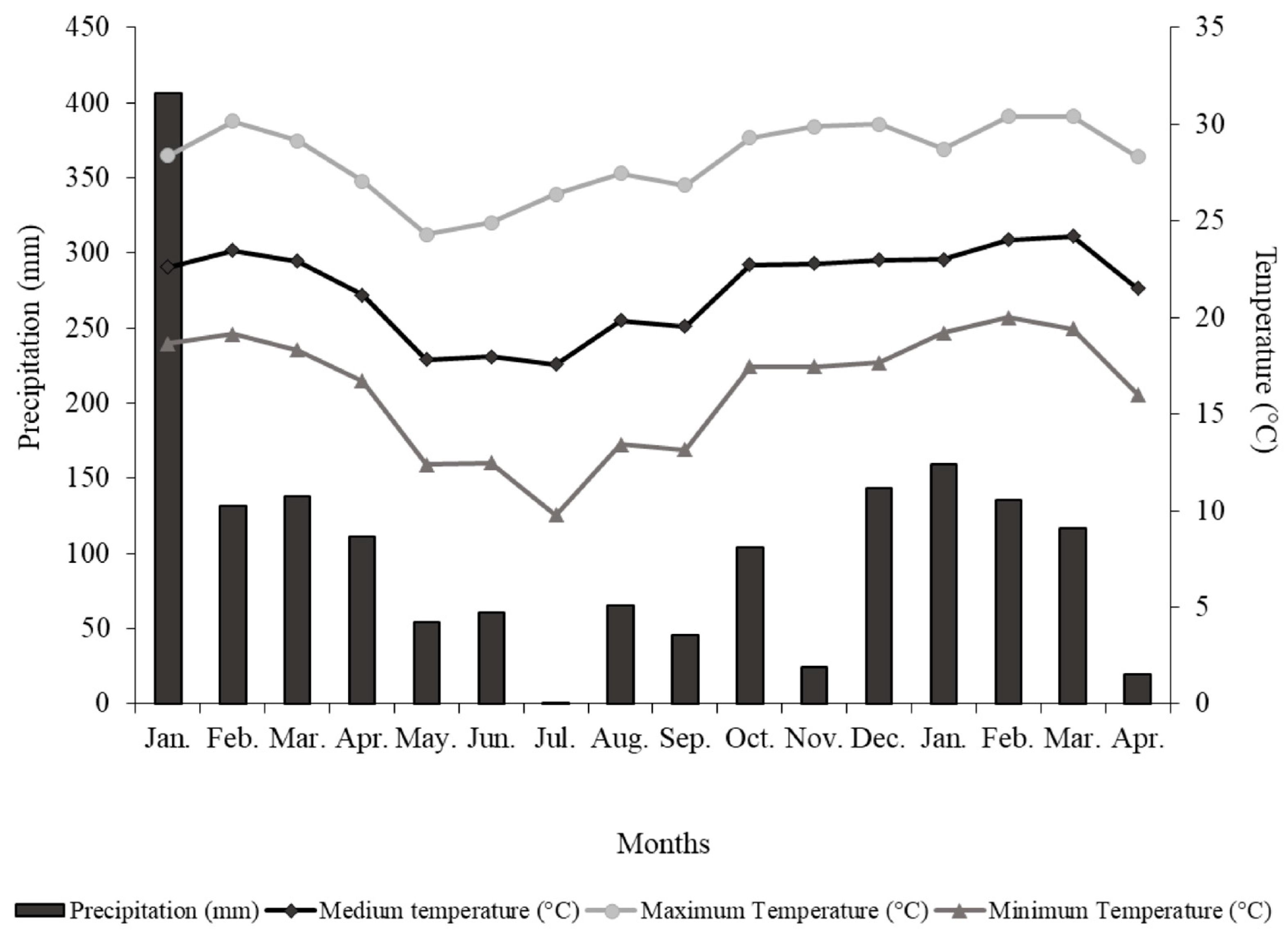
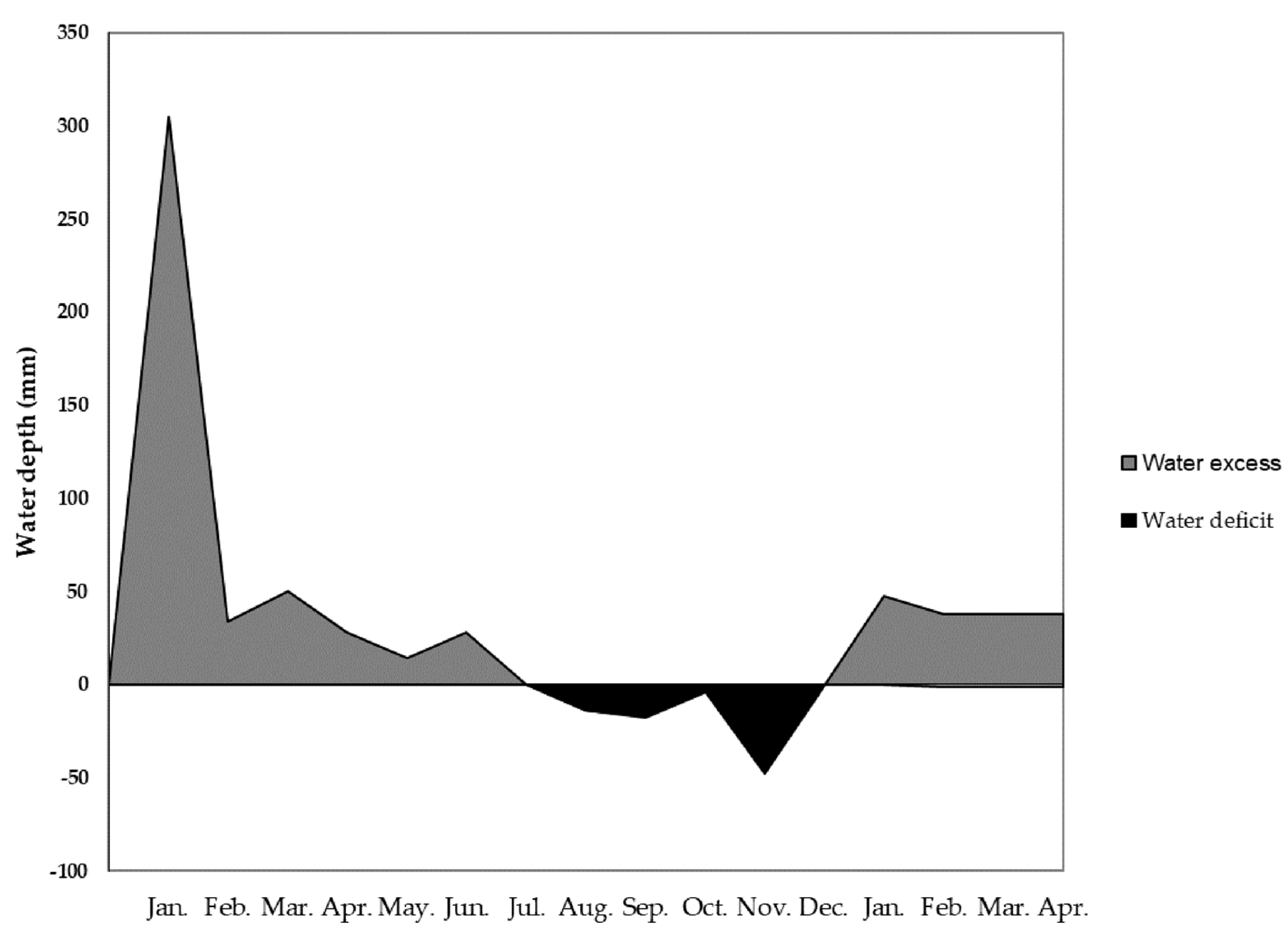
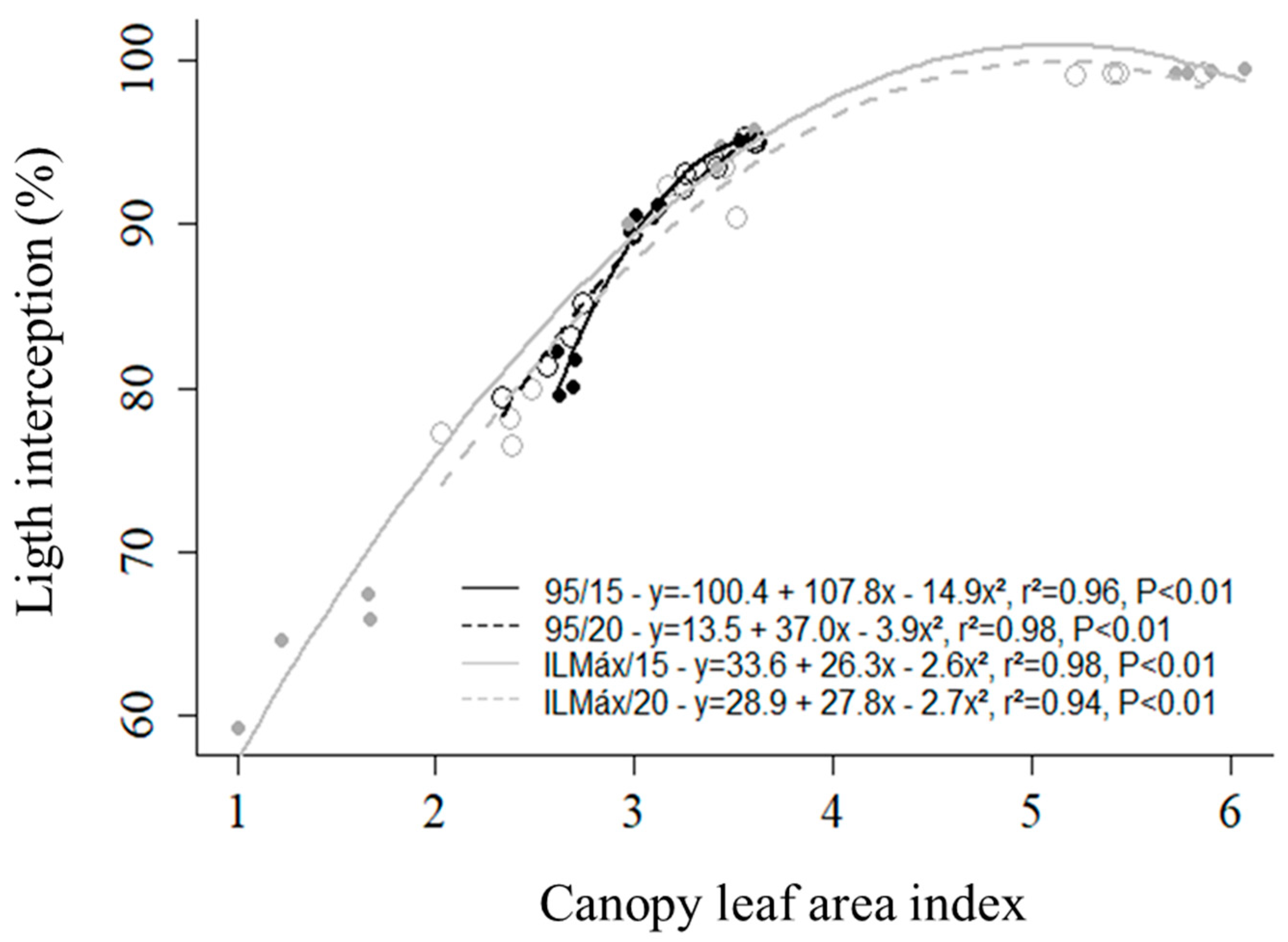
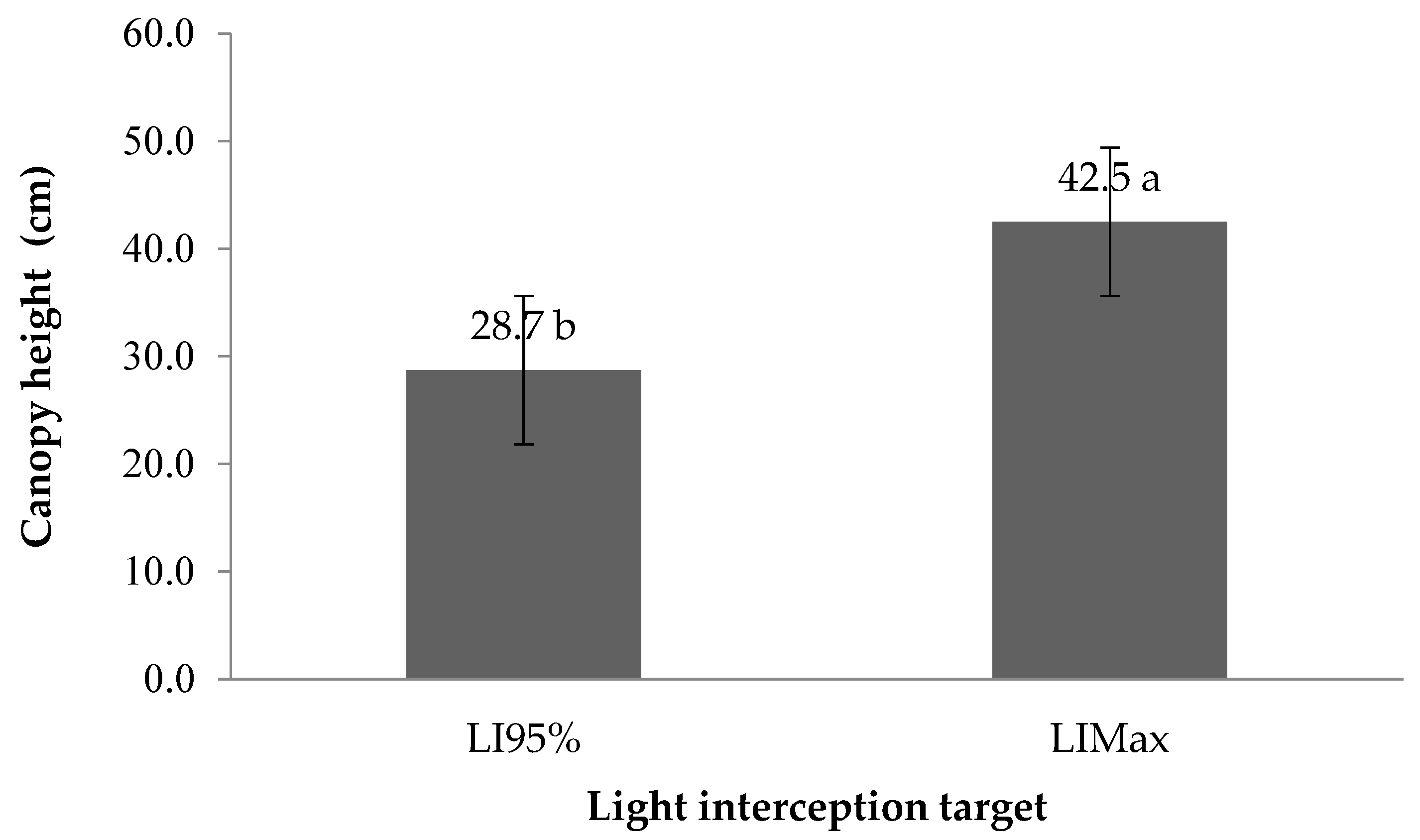
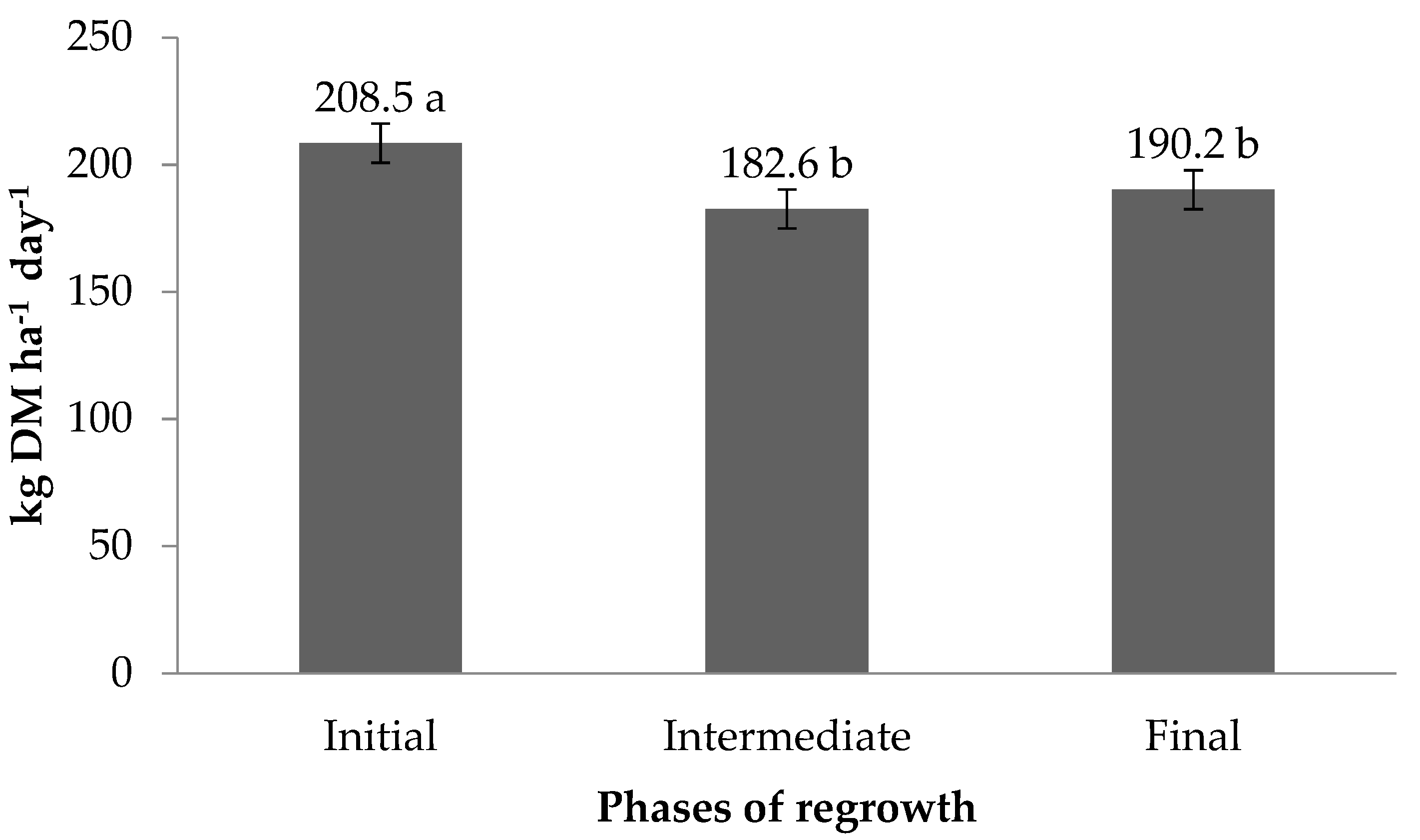
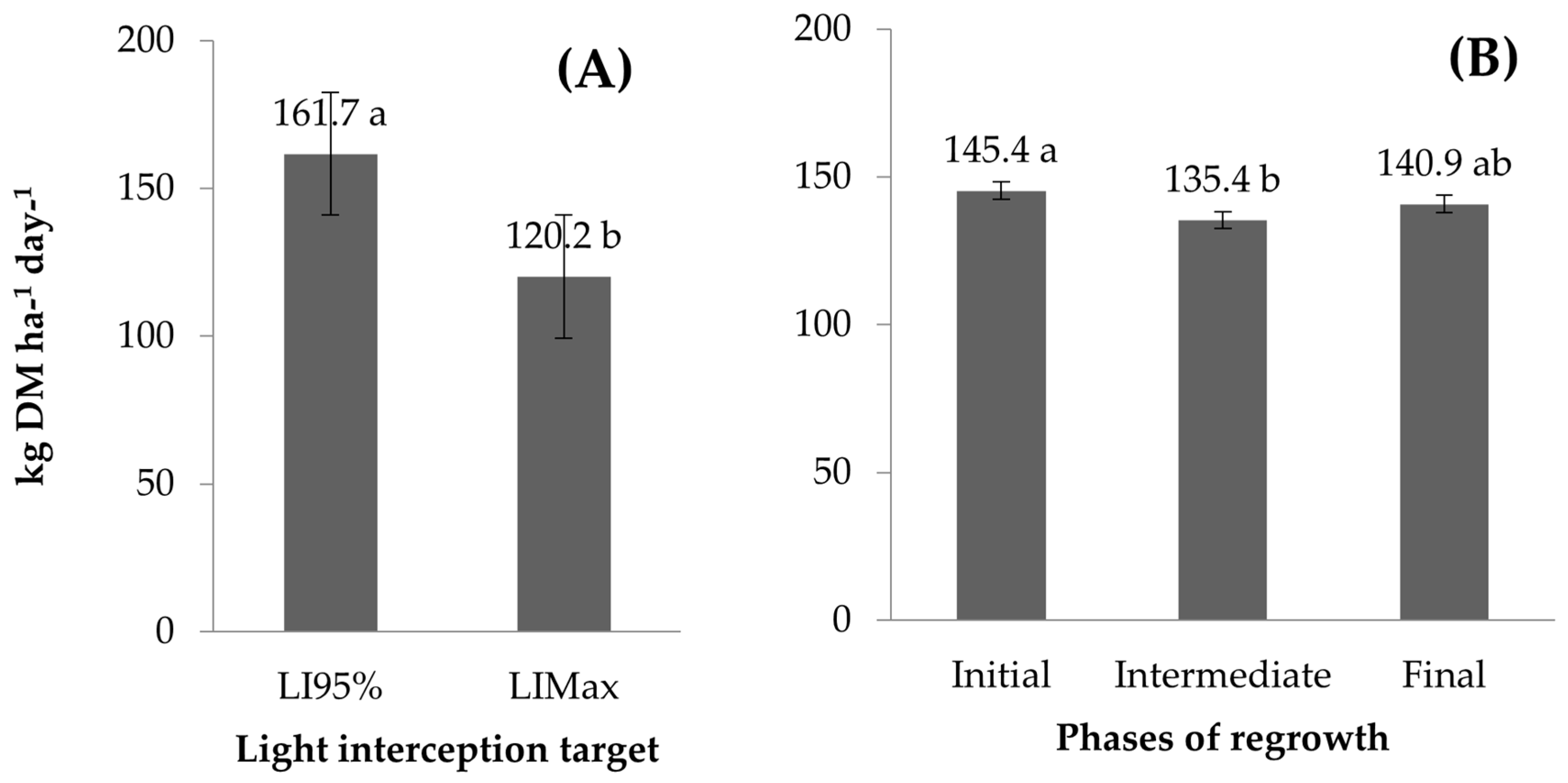
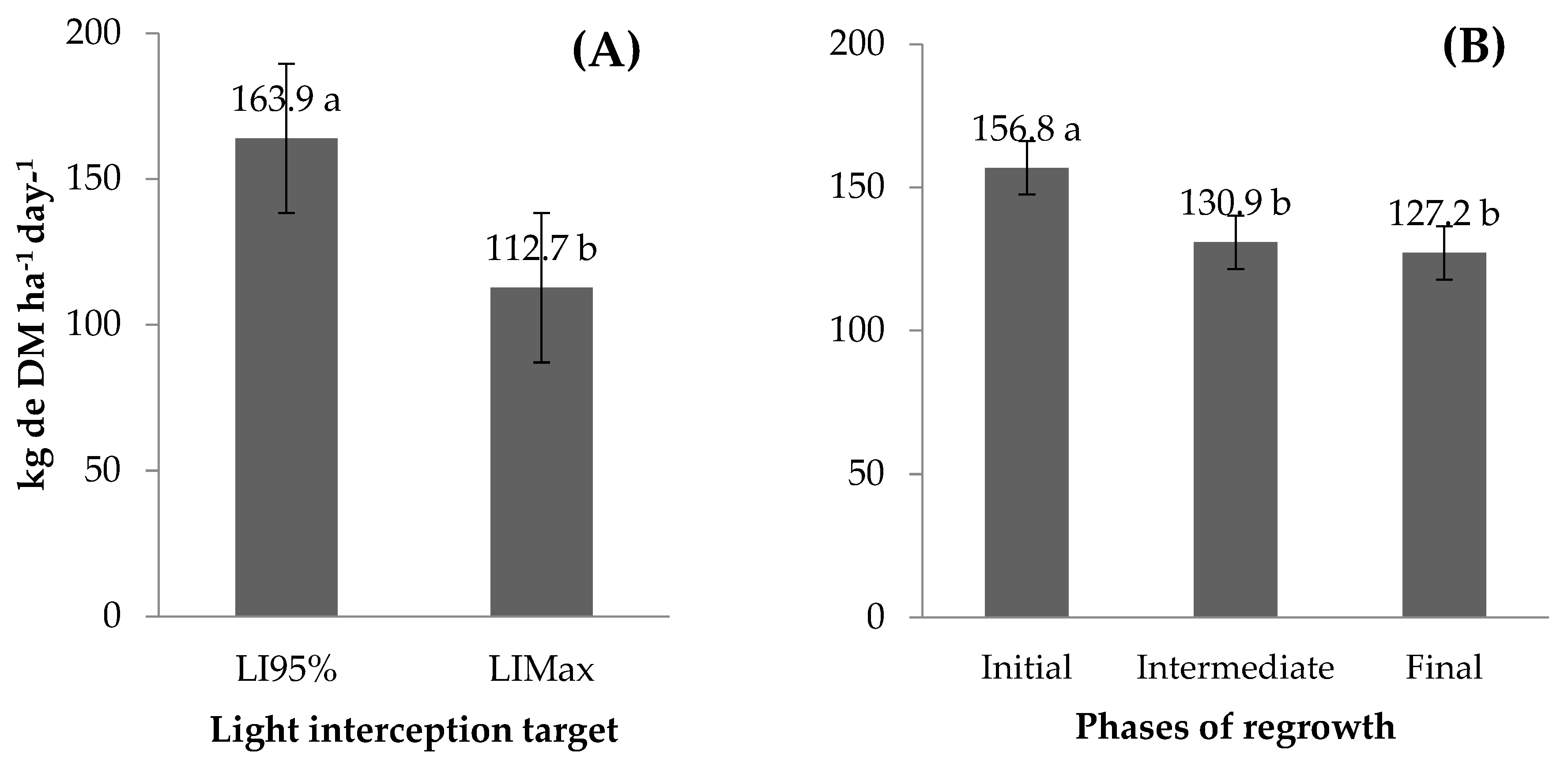
| Post-Grazing Height (cm) | Pre-Grazing LI Target ‡ | |
|---|---|---|
| LI95% | LIMax | |
| Initial phase (SEM = 0.70) † | ||
| 15 | 80.9 | 64.3 |
| 20 | 82.7 | 78.0 |
| Intermediate phase (SEM = 0.27) | ||
| 15 | 90.5 | 95.0 |
| 20 | 93.2 | 94.4 |
| Final phase (SEM = 0.04) | ||
| 15 | 95.1 | 99.3 |
| 20 | 95.1 | 99.2 |
| Post-Grazing Height (cm) | Pre-Grazing LI Target ‡ | |
|---|---|---|
| LI95% | LIMax | |
| Initial phase (SEM = 0.20) † | ||
| 15 | 14.8 | 20.8 |
| 20 | 20.0 | 20.5 |
| Intermediate phase (SEM = 0.43) | ||
| 15 | 22.6 | 32.8 |
| 20 | 25.8 | 33.4 |
| Final phase (SEM = 0.36) | ||
| 15 | 27.7 | 40.9 |
| 20 | 29.8 | 44.2 |
| Regrowth Phase | Pre-Grazing LI Targets ‡ | SEM † | |
|---|---|---|---|
| LI95% | LIMax | ||
| (kg ha−1·day−1) | |||
| Initial | 71.0 Aa | 46.3 Bab | 4.2 |
| Intermediate | 51.7 Ab | 40.4 Bb | 4.2 |
| Final | 45.2 Bb | 53.5 Aa | 5.4 |
| Regrowth Phase | Post-Grazing Height (cm) | SEM † | |
|---|---|---|---|
| 15 | 20 | ||
| (kg ha−1·day−1) | |||
| Initial | 45.5 Ba | 71.8 Aa | 4.2 |
| Intermediate | 43.2 Aa | 48.8 Ab | 4.2 |
| Final | 48.2 Aa | 50.5 Ab | 5.4 |
| Regrowth Phase | Pre-Grazing LI Targets ‡ | SEM † | |
|---|---|---|---|
| LI95% | LIMax | ||
| (kg ha−1 day−1) | |||
| Initial | 60.9 Aa | 42.4 Bc | 5.5 |
| Intermediate | 46.7 Aa | 56.8 Ab | 5.0 |
| Final | 53.9 Ba | 72.3 Aa | 5.0 |
| Regrowth Phase | Pre-Grazing LI Targets ‡ | SEM † | |
|---|---|---|---|
| LI95% | LIMax | ||
| Initial | 0.27 Aa | 0.30 Ab | 0.03 |
| Intermediate | 0.23 Ba | 0.44 Aa | 0.03 |
| Final | 0.27 Ba | 0.47 Aa | 0.03 |
Disclaimer/Publisher’s Note: The statements, opinions and data contained in all publications are solely those of the individual author(s) and contributor(s) and not of MDPI and/or the editor(s). MDPI and/or the editor(s) disclaim responsibility for any injury to people or property resulting from any ideas, methods, instructions or products referred to in the content. |
© 2024 by the authors. Licensee MDPI, Basel, Switzerland. This article is an open access article distributed under the terms and conditions of the Creative Commons Attribution (CC BY) license (https://creativecommons.org/licenses/by/4.0/).
Share and Cite
Rodrigues, C.S.; da Silveira, M.C.T.; Barbero, L.M.; Sousa Júnior, S.J.; Limão, V.A.; Silva, G.P.; da Silva, S.C.; do Nascimento Júnior, D. Dynamics of Mulatto Grass Regrowth Depending on Rotational Cattle Grazing Management. Grasses 2024, 3, 174-189. https://doi.org/10.3390/grasses3030013
Rodrigues CS, da Silveira MCT, Barbero LM, Sousa Júnior SJ, Limão VA, Silva GP, da Silva SC, do Nascimento Júnior D. Dynamics of Mulatto Grass Regrowth Depending on Rotational Cattle Grazing Management. Grasses. 2024; 3(3):174-189. https://doi.org/10.3390/grasses3030013
Chicago/Turabian StyleRodrigues, Carlindo Santos, Márcia Cristina Teixeira da Silveira, Leandro Martins Barbero, Salim Jacaúna Sousa Júnior, Veridiana Aparecida Limão, Guilherme Pontes Silva, Sila Carneiro da Silva, and Domicio do Nascimento Júnior. 2024. "Dynamics of Mulatto Grass Regrowth Depending on Rotational Cattle Grazing Management" Grasses 3, no. 3: 174-189. https://doi.org/10.3390/grasses3030013
APA StyleRodrigues, C. S., da Silveira, M. C. T., Barbero, L. M., Sousa Júnior, S. J., Limão, V. A., Silva, G. P., da Silva, S. C., & do Nascimento Júnior, D. (2024). Dynamics of Mulatto Grass Regrowth Depending on Rotational Cattle Grazing Management. Grasses, 3(3), 174-189. https://doi.org/10.3390/grasses3030013






